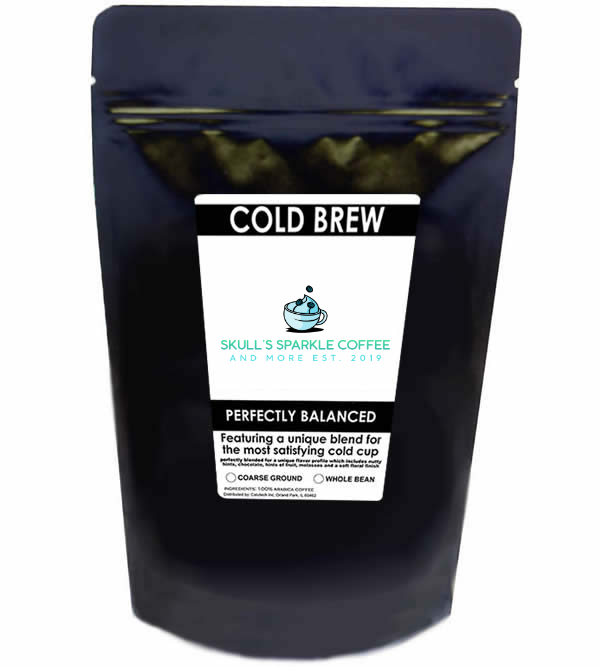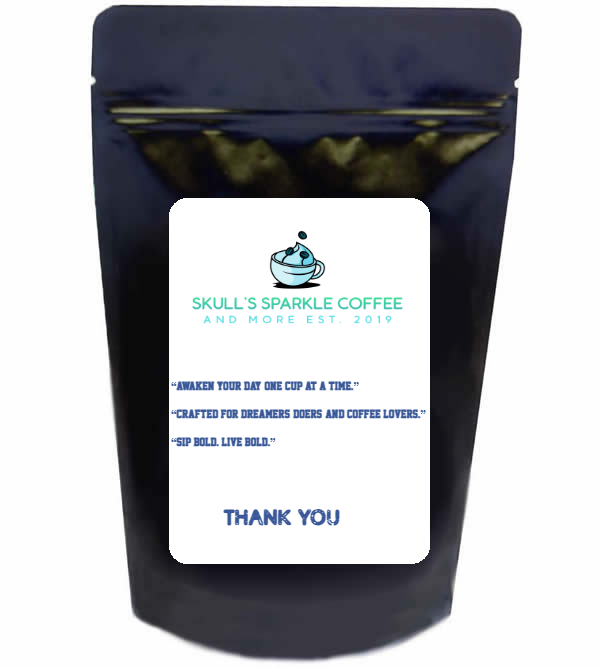SKULL'S SPARKLE COFFEE AND MORE
Cold Brew Blend Coffee - I THE SKULL
Cold Brew Blend Coffee - I THE SKULL
Couldn't load pickup availability
DESCRIPTION
A blend of coffees from Africa, Central and South America. Offers deep earth notes and a very heavy body making this blend perfect for Cold Brew coffee.
Cold brew coffee is a special blend of unique coffee beans that offer deep earth tones. Similar to tea, cold brew coffee is steeped, and once finished the grounds are filtered out. This offers a concentrated coffee, well balanced and bold, that is often consumed by mixing with milk or just water, served over ice. Cold brew coffee uses prolonged time for brewing, unlike hot coffee, which extracts the oils, sugars and caffeine from the beans. This results in a coffee drink that is less acidic (making it popular with people who have sensitive stomachs) and it’s also less bitter than hot coffee. Cold brew coffee is a dark French roast and the grounds are very coarse. It’s easy to make, even with a couple mason jars and a filter, or with a coffee maker made specifically for cold brew. YouTube also shows many methods of making cold brew coffee at home with items already in your kitchen.
Cold Brew (Extra Dark)
Near French Roast coffee beans blended for great flavor when consumed as cold coffee, but also delicious hot as well. These coffee beans are blended from a secret recipe that includes South American and Central American coffee beans to create unmatched consistent flavor cold or hot.
Cold brew coffee is a popular coffee preparation method where coffee grounds are steeped in cold water for an extended period, typically 12 to 24 hours, to extract the flavor and caffeine from the beans. The resulting coffee is less acidic and smoother than traditional hot brewed coffee.
The cold brewing process is a slow and gentle extraction method that requires coarse coffee grounds and cold or room temperature water. The coffee is steeped for an extended period, allowing for the coffee’s natural flavors and aromas to infuse into the water.
Once the steeping period is complete, the coffee is filtered to remove the grounds, resulting in a concentrate that can be diluted with water or milk. The concentrate can be stored in the refrigerator for up to two weeks and used as needed.
Cold brew coffee has gained popularity due to its smooth, low-acid taste, and its ability to be served over ice or mixed with milk or cream. It’s also a popular option for those who prefer a less bitter coffee taste or have sensitive stomachs that are sensitive to the acidity in traditional hot brewed coffee.
It’s worth noting that while cold brew coffee has less acidity than hot brewed coffee, it still contains caffeine and should be consumed in moderation. Additionally, the brewing process requires a higher ratio of coffee grounds to water, which may result in a more expensive cup of coffee compared to traditional hot brewed coffee.
ORIGINS COUNTRIES
Colombia
Tasting notes include toffee, apples and a fairly heavy body. This coffee is grown in the Antioquia and Calda regions at elevations between 3,800 and 4,400. Colombia is in South America at its northern tip and borders Ecuador and Venezuela. Nicaragua is to the north.
Ingredients: 100% Arabica Coffee.
Costa Rica
Tasting notes include raisins, walnut and green apples with a medium body. This coffee is grown at an elevation of 5,900 feet in the higher mountain peaks of the Tarrazu growing region of the San Jose province. This province is known for the best coffee beans in the country. The bean variety is Arabica and includes a well balanced mix of Caturra and Catuai varieties. To the west of Tarrazu is the Dota growing region where some world renowned coffee beans are also grown. Costa Rica is in Central America with Nicaragua to the north and Panama to the south. East of the country is the Caribbean Sea and to the west is the Pacific Ocean.
Ingredients: 100% Arabica Coffee.
El Salvador
Tasting notes include nuts, chocolate, brown sugar and a heavy body. This coffee is grown at an elevation of 3,600 feet with Arabica bean varieties that include Pacas, Caturra and Bourbon. It is harvested in the Apaneca Mountains where coffee plants are surrounded by fruit trees, offering a perfect shade grown environment. El Salvador is in Central America. Guatemala is to its northwest and Honduras to the northeast. Moving south you would enter Nicaragua.
Ingredients: 100% Arabica Coffee.
Honduras
Tasting notes include caramel, red fruits and chocolate. This coffee is grown at an elevation of 4,500 feet in the Intibuca Department of the Western Highlands. The mountains are full of pine and oak trees, with valleys covered in vegetation due to the tropical soils that are always full of moisture. Honduras is in Central America with Guatemala and Belize to the north. The southern border includes El Salvador and Nicaragua.
Ingredients: 100% Arabica Coffee
Nicaragua
Tasting notes include sweet, citric, caramel and a bright finish with an occasional hint of milk chocolate. This coffee is grown at an elevation of 4,900 feet in the northern part of the Matagalpa region. It’s a mixed Arabica variety of Caturra, Catuai, and Maragogipe coffee beans, which brings this coffee’s unique flavor together. Nicaragua is in Central America just south of El Salvador and Honduras. South of its border is Colombia, the beginning of South America.
Ingredients: 100% Arabica Coffee.
Peru
Tasting notes include chocolate, caramel, almond, raisin and a heavy body. This coffee comes from the central Peruvian province of Huanauco and is grown at an elevation of 6,200 feet. The region was once the home of the Inca Empire. It’s warm in the day and cool at night with an average temperature of 68 degrees Fahrenheit, making it perfect for growing great coffee beans. Peru is located in South America on the western edge, below Colombia and west of Brazil. Bolivia is to its south.
Ingredients: 100% Arabica Coffee.



